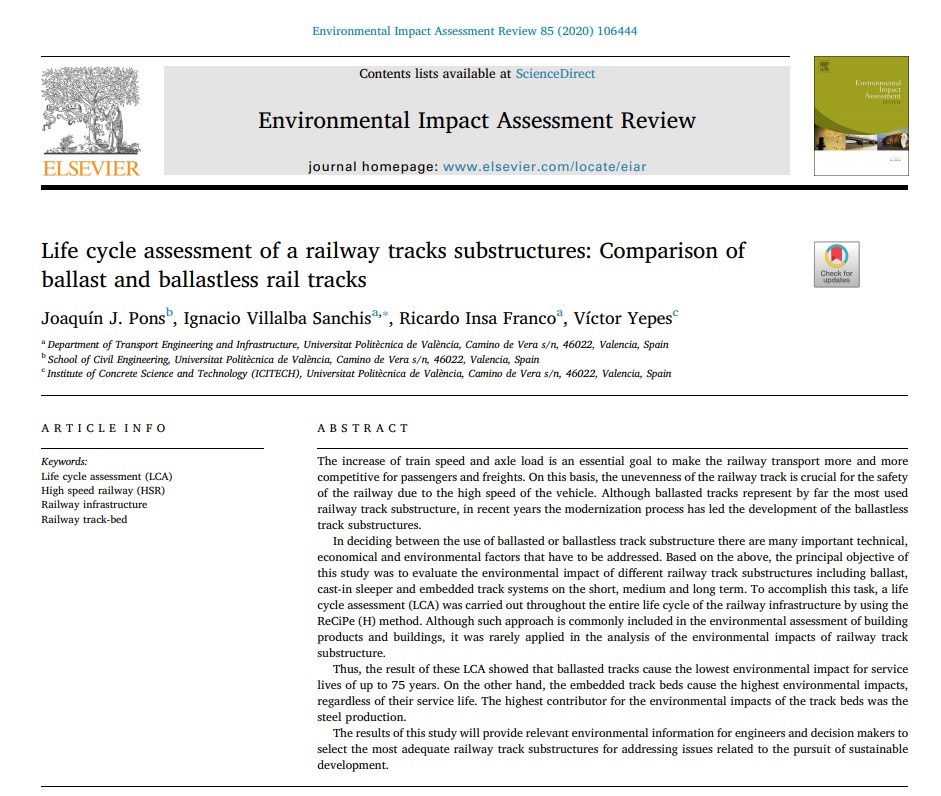 Nos acaban de publicar en la revista de Elsevier del primer cuartil, Environmental Impact Assessment Review, un artículo donde se analiza el ciclo de vida del balasto frente la alternativa de vía en placa. Este artículo forma parte de nuestra línea de investigación DIMALIFE en la que se pretenden optimizar estructuras atendiendo no sólo a su coste, sino al impacto ambiental y social que generan a lo largo de su ciclo de vida.
Nos acaban de publicar en la revista de Elsevier del primer cuartil, Environmental Impact Assessment Review, un artículo donde se analiza el ciclo de vida del balasto frente la alternativa de vía en placa. Este artículo forma parte de nuestra línea de investigación DIMALIFE en la que se pretenden optimizar estructuras atendiendo no sólo a su coste, sino al impacto ambiental y social que generan a lo largo de su ciclo de vida.
El artículo lo podéis descargar GRATUITAMENTE hasta el 7 de septiembre de 2020 en el siguiente enlace:
https://authors.elsevier.com/a/1bQbriZ5t2ZYO
ABSTRACT:
The increase of train speed and axle load is an essential goal to make the railway transport more and more competitive for passengers and freights. On this basis, the unevenness of the railway track is crucial for the safety of the railway due to the high speed of the vehicle. Although ballasted tracks represent by far the most used railway track substructure, in recent years the modernization process has led the development of the ballastless track substructures.
In deciding between the use of ballasted or ballastless track substructure there are many important technical, economical and environmental factors that have to be addressed. Based on the above, the principal objective of this study was to evaluate the environmental impact of different railway track substructures including ballast, cast-in sleeper and embedded track systems on the short, medium and long term. To accomplish this task, a life cycle assessment (LCA) was carried out throughout the entire life cycle of the railway infrastructure by using the ReCiPe (H) method. Although such approach is commonly included in the environmental assessment of building products and buildings, it was rarely applied in the analysis of the environmental impacts of railway track substructure.
Thus, the result of these LCA showed that ballasted tracks cause the lowest environmental impact for service lives of up to 75 years. On the other hand, the embedded track beds cause the highest environmental impacts, regardless of their service life. The highest contributor for the environmental impacts of the track beds was the steel production.
The results of this study will provide relevant environmental information for engineers and decision makers to select the most adequate railway track substructures for addressing issues related to the pursuit of sustainable development.
HIGHLIGHTS:
- Rail construction and maintenance phases should not be neglected in LCA approach.
- LCA of rail track require more standardized assessment procedures.
- Environmental LCA of different railway track substructures were analyzed.
- Damage categories have been normalized for the total environmental impact.
- Future LCA of rail projects should also consider the time effect.
KEYWORDS:
Life cycle assessment (LCA); High speed railway (HSR); Railway infrastructure; Railway track-bed
REFERENCE:
PONS, J.J.; VILLALBA-SANCHIS, I.; INSA, R.; YEPES, V. (2020). Life cycle assessment of a railway tracks substructures: comparison of ballast and ballastless rail tracks. Environmental Impact Assessment Review, 85:106444. DOI:10.1016/j.eiar.2020.106444
